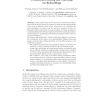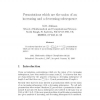116 search results - page 2 / 24 » Suballowable sequences of permutations |
ICALP
2001
Springer
13 years 9 months ago
2001
Springer
Abstract. If the genetic maps of two species are modelled as permutations of (homologous) genes, the number of chromosomal rearrangements in the form of deletions, block moves, inv...
CPC
2002
13 years 5 months ago
2002
The space of permutation pseudographs is a probabilistic model of 2-regular pseudographs on n vertices, where a pseudograph is produced by choosing a permutation of {1, 2, . . . ...
COMBINATORICS
1998
13 years 5 months ago
1998
It is shown that there are 2n n − n−1 m=0 2n−m−1 2m m permutations which are the union of an increasing sequence and a decreasing sequence. 1991 Mathematics Subject Classi...
CPM
2004
Springer
13 years 10 months ago
2004
Springer
A popular approach in comparative genomics is to locate groups or clusters of orthologous genes in multiple genomes and to postulate functional association between the genes contai...
WABI
2001
Springer
13 years 9 months ago
2001
Springer
Abstract. Comparing gene orders in completely sequenced genomes is a standard approach to locate clusters of functionally associated genes. Often, gene orders are modeled as permut...


